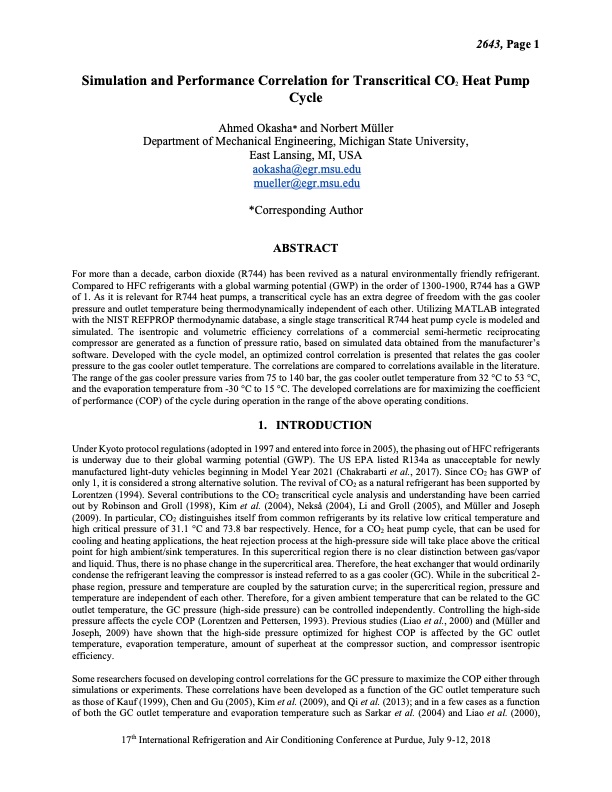
PDF Publication Title:
Text from PDF Page: 002
2643, Page 1 Simulation and Performance Correlation for Transcritical CO2 Heat Pump Cycle Ahmed Okasha* and Norbert Müller Department of Mechanical Engineering, Michigan State University, East Lansing, MI, USA aokasha@egr.msu.edu mueller@egr.msu.edu *Corresponding Author ABSTRACT For more than a decade, carbon dioxide (R744) has been revived as a natural environmentally friendly refrigerant. Compared to HFC refrigerants with a global warming potential (GWP) in the order of 1300-1900, R744 has a GWP of 1. As it is relevant for R744 heat pumps, a transcritical cycle has an extra degree of freedom with the gas cooler pressure and outlet temperature being thermodynamically independent of each other. Utilizing MATLAB integrated with the NIST REFPROP thermodynamic database, a single stage transcritical R744 heat pump cycle is modeled and simulated. The isentropic and volumetric efficiency correlations of a commercial semi-hermetic reciprocating compressor are generated as a function of pressure ratio, based on simulated data obtained from the manufacturer’s software. Developed with the cycle model, an optimized control correlation is presented that relates the gas cooler pressure to the gas cooler outlet temperature. The correlations are compared to correlations available in the literature. The range of the gas cooler pressure varies from 75 to 140 bar, the gas cooler outlet temperature from 32 °C to 53 °C, and the evaporation temperature from -30 °C to 15 °C. The developed correlations are for maximizing the coefficient of performance (COP) of the cycle during operation in the range of the above operating conditions. 1. INTRODUCTION Under Kyoto protocol regulations (adopted in 1997 and entered into force in 2005), the phasing out of HFC refrigerants is underway due to their global warming potential (GWP). The US EPA listed R134a as unacceptable for newly manufactured light-duty vehicles beginning in Model Year 2021 (Chakrabarti et al., 2017). Since CO2 has GWP of only 1, it is considered a strong alternative solution. The revival of CO2 as a natural refrigerant has been supported by Lorentzen (1994). Several contributions to the CO2 transcritical cycle analysis and understanding have been carried out by Robinson and Groll (1998), Kim et al. (2004), Nekså (2004), Li and Groll (2005), and Müller and Joseph (2009). In particular, CO2 distinguishes itself from common refrigerants by its relative low critical temperature and high critical pressure of 31.1 °C and 73.8 bar respectively. Hence, for a CO2 heat pump cycle, that can be used for cooling and heating applications, the heat rejection process at the high-pressure side will take place above the critical point for high ambient/sink temperatures. In this supercritical region there is no clear distinction between gas/vapor and liquid. Thus, there is no phase change in the supercritical area. Therefore, the heat exchanger that would ordinarily condense the refrigerant leaving the compressor is instead referred to as a gas cooler (GC). While in the subcritical 2- phase region, pressure and temperature are coupled by the saturation curve; in the supercritical region, pressure and temperature are independent of each other. Therefore, for a given ambient temperature that can be related to the GC outlet temperature, the GC pressure (high-side pressure) can be controlled independently. Controlling the high-side pressure affects the cycle COP (Lorentzen and Pettersen, 1993). Previous studies (Liao et al., 2000) and (Müller and Joseph, 2009) have shown that the high-side pressure optimized for highest COP is affected by the GC outlet temperature, evaporation temperature, amount of superheat at the compressor suction, and compressor isentropic efficiency. Some researchers focused on developing control correlations for the GC pressure to maximize the COP either through simulations or experiments. These correlations have been developed as a function of the GC outlet temperature such as those of Kauf (1999), Chen and Gu (2005), Kim et al. (2009), and Qi et al. (2013); and in a few cases as a function of both the GC outlet temperature and evaporation temperature such as Sarkar et al. (2004) and Liao et al. (2000), 17th International Refrigeration and Air Conditioning Conference at Purdue, July 9-12, 2018PDF Image | Transcritical CO2 Heat Pump Cycle

PDF Search Title:
Transcritical CO2 Heat Pump CycleOriginal File Name Searched:
220147355.pdfDIY PDF Search: Google It | Yahoo | Bing
CO2 Organic Rankine Cycle Experimenter Platform The supercritical CO2 phase change system is both a heat pump and organic rankine cycle which can be used for those purposes and as a supercritical extractor for advanced subcritical and supercritical extraction technology. Uses include producing nanoparticles, precious metal CO2 extraction, lithium battery recycling, and other applications... More Info
Heat Pumps CO2 ORC Heat Pump System Platform More Info
| CONTACT TEL: 608-238-6001 Email: greg@infinityturbine.com | RSS | AMP |